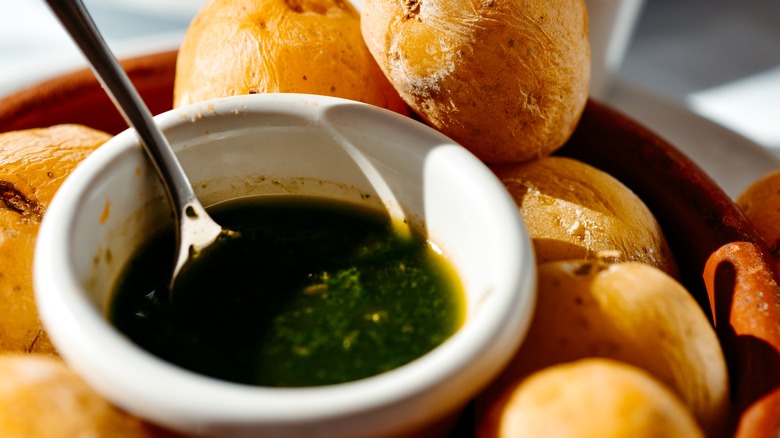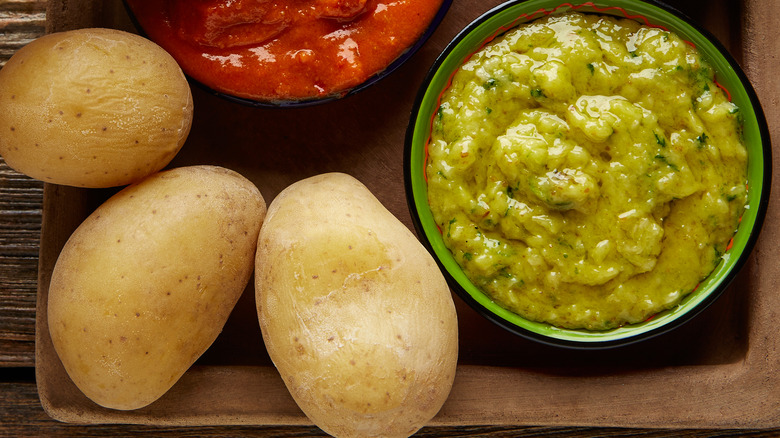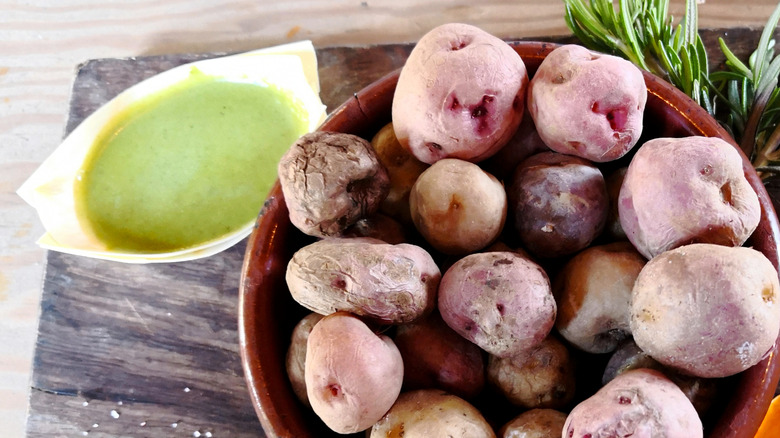Mojo Verde Is The Spanish Green Sauce To Elevate Your Potatoes
From chimichurri to pesto, herb-based sauces assert a strong character that meshes with a broad range of components. Whether topping grilled meats or pasta, their flavor can either define a dish or add a subtle, complex element.
For an even more pungent green sauce, look to mojo verde. Typically olive oil-based, it comes loaded with cilantro, cumin, vinegar, and garlic, lending it a unique character. Long crafted in a mortar and pestle, it can be used as a marinade atop grilled meats or simply a tableside condiment — it is particularly popular, however, as a topping for potatoes.
Mojo verde originates from the Canary Islands, where it's part of a trio of other garlic and vinegar-based sauces. Its emergence showcases the region's globalized proximity — cumin from neighboring Africa, olive oil from the Spanish mainland, and island-grown potatoes cooked in salt water. Below, a breakdown of how this flavorful sauce comes together.
How is mojo verde made?
Today, most mojo verde concoctions are crafted in a food processor, not the mortar and pestle that has long served as its traditional method. Although more labor-intensive, the old-school method releases more oils and results in a brighter flavor.
Pulverizing begins with a substantial serving of garlic — around six cloves — and plenty of salt. Next, toasted cumin is introduced. Typically, mojo verde uses cilantro as an herb base, although newer recipes call for parsley, chives, oregano, and a shifting combination of other aromatics. The mixture is mashed until thoroughly combined. The olive oil is then slowly drizzled in, while the sauce continues to be mixed. Once it's all a pulpy, slightly liquid consistency, a small amount of water and sherry vinegar are added to finish.
If making your mojo verde in a blender, it's important to periodically pause blending and scrape the aromatics back into the mixture. The green sauce should have a homogenous texture, with only a small separation between the oil and other elements.
How to pump up your potatoes with mojo verde
Mojo verde especially shines when slathered on potatoes — the thick, carby tubers are the perfect vessel for those herbs and olive oil. Typically, the root vegetables are prepared in a dish known as papas arrugadas, which translates to wrinkled potatoes.
The preparation involves small potatoes, which were introduced to the islands in the 1600s. To create their salt-encrusted, wrinkled exterior, the vegetables are boiled in ocean water. Since such an effect can also be mimicked by diluting tap water with sea salt, you can try this at home without much trouble. Once the potatoes are soft, they're momentarily steamed sans water to form their crust. Sliced open, the mojo verde can then be garnished on top, or used as a dipping sauce.
To craft a whole meal, consider also grilling meats and chicken, which can then be marinated in the sauce. Add some roasted vegetables or toasted bread to the spread. Mojo verde will seamlessly impart its bold character to a medley of foods — transforming simple ingredients into a flavorful affair.


